NASA's Curiosity and Opportunity rovers aren't the only human-made objects that have been on the move on Mars: The Red Planet's winds have set Curiosity's discarded parachute rolling around on the surface, as seen in a series of images captured by the Mars Reconnaissance Orbiter over the course of five months.
The 65-foot-wide (20-meter-wide) parachute and the rover's protective backshell were thrown clear of the rover while it descended to its historic landing in Mars' Gale Crater last August. For a few weeks thereafter, they pretty much stayed where they were. But by the end of November, the orbiter's sharp-eyed HiRISE camera picked up changes in the parachute's shape and position. What's more, the dark marks left on the Martian surface by the backshell's impact started fading away.
The fading of the dark streaks could be explained by the deposition of airborne dust, according to the University of Arizona's Alfred McEwen, who heads the HiRISE science team. The winds that whip through Mars' thin atmosphere are also thought to be responsible for the parachute's changing position.
"This type of motion may kick off dust and keep parachutes on the surface bright, to help explain why the parachute from Viking 1 (landed in 1976) remains detectable," McEwen wrote in Wednesday's image advisory.
If you have red-blue glasses, check out this 3-D view of the parachute and the backshell.

Although the parachute may be on the move, Curiosity itself is definitely staying put for the rest of the month: Mars and Earth are on directly opposite sides of the sun, which interferes with radio communication. As a result, NASA will suspend sending commands to the rover starting on Thursday. Opportunity, MRO and the Mars Odyssey orbiter will be out of radio contact for most of April as well. Curiosity and Opportunity will be executing pre-programmed commands to continue their scientific work, and both rovers are expected to be back on the move in May.
More about Mars:
- Curiosity resumes rock analysis after glitch
- How a Martian mountain would look on Earth
- NBC News archive on Mars
Alan Boyle is NBCNews.com's science editor. Connect with the Cosmic Log community by "liking" the log's Facebook page, following @b0yle on Twitter and adding the Cosmic Log page to your Google+ presence. To keep up with Cosmic Log as well as NBCNews.com's other stories about science and space, sign up for the Tech & Science newsletter, delivered to your email in-box every weekday. You can also check out "The Case for Pluto," my book about the controversial dwarf planet and the search for new worlds.